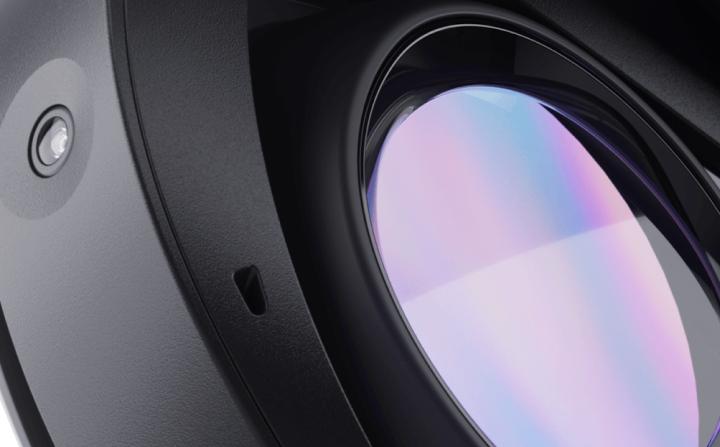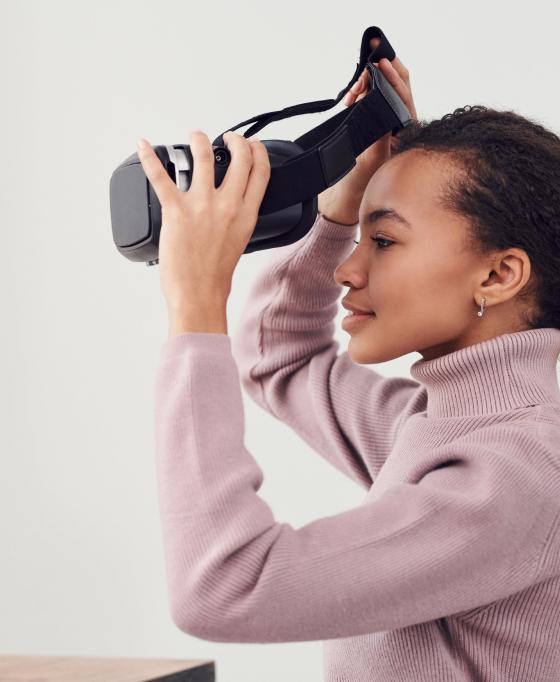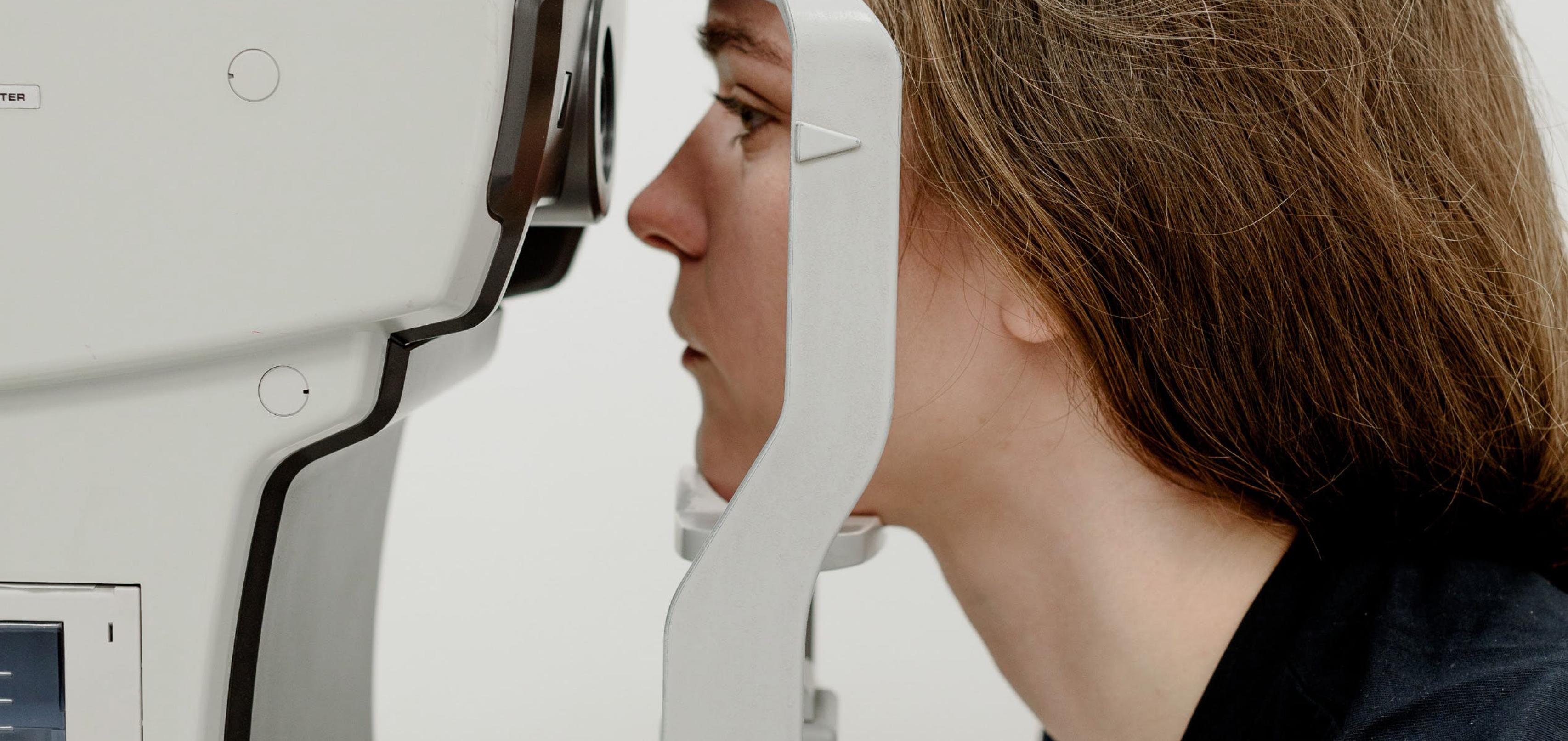Virtual reality for vision therapy
What is virtual reality vision therapy?
Virtual reality (VR) vision therapy is a treatment method that uses the power of virtual reality, including virtual reality headsets, to address various vision-related conditions and disorders, such as binocular vision issues like strabismus, amblyopia, and convergence insufficiency.
During therapy, patients are immersed in a virtual environment designed to enhance visual acuity, depth perception, contrast sensitivity, eye movements, and dynamic visual acuity. Additionally, VR eye care may alleviate symptoms like headaches or blurred vision.
Applications of VR in ophthalmology
VR is used in vision therapy to create virtual 3D environments. Patients are presented with objects, images, and tasks that require them to interact with their environment while wearing a virtual reality headset.
The visuals can be tailored to the individual’s eye problems, allowing practitioners to personalize the experience for each patient. In addition to this interactive element, VR also provides feedback on performance, which helps patients track their progress throughout treatment.
VR technology is widely used for binocular vision therapy, a specialized treatment addressing conditions like convergence insufficiency, strabismus, amblyopia, and eye teaming difficulties. Binocular therapy aims to enhance the coordination and function of both eyes, and VR proves beneficial in achieving both.
VR for vision therapy: market stats
Recent studies show that VR’s role in vision therapy remains promising and can serve as an invaluable tool for clinicians in restoring optimal visual function for their patients. Both the trials and recent significant breakthroughs in this field provide concrete evidence:
01
The global market for VR in healthcare is set to increase from $3.11B in 2023 to $25.22B by 2030, with a remarkable CAGR of 34.9 percent.
02
In 2024, the commercial applications of augmented and virtual reality (AR/VR) set to receive the most substantial investment are training and industrial maintenance, with an anticipated investment of $4.1B in each sector.
03
Recent research from Sichuan University in China compared virtual reality-based vision therapy to traditional OBVAT (office-based convergence/accommodative therapy) in treating convergence insufficiency (CI).
The study found that both methods effectively improved convergence-related parameters, as demonstrated by successful outcomes in near point of convergence (NPC) and positive changes in Sheard's criteria (vision health Indicators).
The results showed that 81.3 percent of the virtual reality group and 88.2 percent of the OBVAT group achieved normal NPC and positive fusional vergence (PFV). After 12 weeks of therapy, a comparable percentage of patients in both groups achieved NPC values below six cm, with no statistically significant difference.
04
A 2018 study published in Med Hypotheses addresses the global rise in myopia, projecting that 49.8 percent of the world's population will be affected by 2050, particularly in East Asia and the US.
The study focuses on the potential of VR-based binocular visual training as a method for myopia prevention and control.
Certain companies propose that VR technology has the potential to treat or even cure juvenile myopia. By simulating outdoor environments with optimal lighting, VR devices incorporating foveated rendering and eye tracking offer a promising immersive solution. This is especially relevant in areas dealing with challenges like air pollution, which impedes outdoor exercise.
05
The global market for augmented and virtual reality contact lenses is projected to increase from $15M in 2021 to $71.15M by 2031, growing at a CAGR of 16.5 percent.
While VR contact lens development is in its early stages, potential applications in healthcare include aiding physical and cognitive rehabilitation. VR contact lenses could facilitate interactive therapy sessions for patients recovering from injuries or surgeries, enhancing motor skills through engaging exercises.
Use cases of virtual reality in vision therapy
Amblyopia VR treatment
Virtual reality is utilized to treat amblyopia, commonly known as "lazy eye." This innovative approach involves engaging the weaker eye through tailored VR exercises and games, fostering a diligent effort to enhance visual acuity and promote binocular vision.
Strabismus VR treatment
VR therapy for strabismus aims to address eye misalignment through targeted exercises that promote binocular vision. With the help of VR simulations, patients are guided to align their eyes accurately, enhancing eye coordination and depth perception.
Convergence Insufficiency (CI) VR treatment
Virtual reality facilitates the treatment of CI by providing exercises that specifically target the eyes' convergence ability. Patients actively participate in VR activities that demand precise eye coordination, progressively enhancing their convergence skills.
Myopia VR treatment
VR has the potential to mitigate the progression of myopia in children. VR can effectively lower the risk of developing severe nearsightedness by creating an immersive environment that promotes outdoor activities and reduces near work.
Presbyopia VR treatment
VR applications simulate different reading conditions to address presbyopia. Users can effortlessly adjust font sizes and lighting settings, enabling them to find the perfect visual environment for managing age-related near vision challenges.
Age-related macular degeneration (AMD) VR treatment
Virtual reality provides tailored visual support to individuals with AMD, improving their ability to read, watch videos, and participate in activities. Specialized VR devices enhance and enlarge images, ultimately enhancing the quality of life for those with AMD.
Emerging VR eyecare technologies
Foveated rendering
Foveated rendering enhances VR content by monitoring the user's eye movements and prioritizing high-quality graphics exclusively within their line of sight (fovea). Simultaneously, it reduces image quality in the peripheral vision areas.
Such innovations conserve computational resources and hold promise for vision treatment by guaranteeing that therapeutic materials are presented with utmost clarity precisely where the user is gazing. This, in turn, facilitates more impactful eye exercises, contributing to more effective treatment.
Eye tracking
The integration of eye tracking with VR technologies helps monitor the direction of a user's gaze; this opens up a wide range of possibilities for more immersive, efficient, and personalized experiences. In vision treatment, it can be used to assess eye movement disorders and calibrate exercises to target specific visual deficits that allow more precise therapy.
3D visualization and stereoscopic imaging
3D visualization and stereoscopic imaging in VR provide depth perception and stimulate binocular vision. These technologies can be applied to treat conditions like strabismus and amblyopia with immersive virtual environments that encourage the brain to coordinate using both eyes.
Interactive environments
Interactive VR environments engage users in visual exercises and tasks. They can be customized to target specific vision disorders, such as convergence insufficiency, by offering dynamic challenges that require accurate eye coordination and focus adjustments.
Augmented reality (AR) overlays
AR overlays in VR can project visual aids or corrective elements onto the user's view. AR overlays assist individuals with conditions like age-related macular degeneration for vision treatment by enhancing their visual perception and providing real-time guidance.
Customizable visual stimuli
VR offers the capability to craft highly adaptable visual stimuli for research purposes. These stimuli can be finely tuned to meet the specific requirements of individual research goals, facilitating effective investigation of a broad spectrum of visual and perceptual phenomena.
Biofeedback integration
Biofeedback integration in VR tracks physiological responses, such as heart rate or stress levels. It monitors a patient's progress during vision treatment, providing real-time feedback to enhance the effectiveness of therapy and encourage consistent practice.
Display
The screen's dimensions and resolution are critical in determining the pixel density per inch (PPI).
When PPI is low, it can result in a screen-door effect due to pixel magnification. Typically, displays within a Head-Mounted Display (HMD) exceed 500 PPI. When viewed from the headset's distance, the human eye can discern details up to 2000 PPI for most individuals.

Mainboard
Within the mainboard, you'll find an array of sensors, including an accelerometer, gyroscope, and head tracking capabilities.
These sensors adapt the virtual environment to closely replicate the real world. In addition to enhancing immersion, these sensors play a vital role in mitigating the risk of VR-induced discomfort, commonly referred to as VR sickness.

Lens
The high plus lenses are specially shaped to reduce blurry vision.
Fresnel prisms are often used to make the lenses thinner so they fit better with glasses to give a user a wider field of vision.

Headset
Eye-tracking headsets can provide a budget-friendly way for doctors to check patients’ eye movements and help with eye exercises.
These headsets can measure eye activity without the user needing to do anything, making the overall process more accurate. They're handy for assessing and improving eye coordination.
Benefits of virtual reality for vision therapy
Enhanced motivation and compliance with treatment plans
Vision therapy using VR makes the treatment experience more engaging and enjoyable. This, in turn, boosts patient motivation and leads to greater adherence to therapy routines. Through interactive and immersive exercises, individuals are more likely to consistently complete their prescribed treatments, which results in improved treatment outcomes.
Remote accessibility and home usage
VR vision therapy can be accessed from the comfort of one's home, reducing the need for frequent clinic visits. This convenience saves time and allows patients to continue their therapy even when they can't make it to the clinic, improving overall accessibility to care.
Easy progress tracking
Virtual reality systems often come equipped with integrated progress-tracking tools, facilitating effortless monitoring of improvements by patients and healthcare providers. This real-time feedback enables the adjustment of treatment plans as necessary, ensuring that therapy remains effective and customized to the individual's progress.
Challenges that come with VR vision therapy
Challenge
Solution
Individual differences
Challenge
Tailoring VR vision therapy to suit each patient's specific needs can be challenging. People have unique vision issues, and creating personalized VR programs to address these differences effectively is crucial.
Solution
-
Develop customizable VR therapy programs that adapt to individual needs.
-
Employ AI algorithms that can analyze patients' responses and adjust therapy in real-time based on their progress.
Integration with traditional methods
Challenge
Integrating VR vision therapy seamlessly with traditional treatment methods can be complex. Ensuring that VR complements — rather than disrupts — existing therapies and diagnostic tools is a challenge.
Solution
-
Establish guidelines and best practices for integrating VR into traditional vision therapy with a seamless and complementary approach.
-
Encourage interdisciplinary collaboration between VR developers, ophthalmologists, and vision therapists to create cohesive treatment plans.
Lack of long-term studies
Challenge
There's a need for more extensive, long-term studies to assess the effectiveness and sustainability of VR vision therapy over extended periods. Understanding how well patients maintain improvements over time is essential.
Solution
-
Allocate funding and resources for long-term research studies to assess VR vision therapy's sustained benefits and potential long-lasting effects.
-
Collaborate with universities and research institutions to conduct comprehensive, longitudinal studies.
Standardization of protocols
Challenge
Ensuring consistency and quality of care in VR vision therapy requires the establishment of standardized protocols. It is imperative to develop comprehensive guidelines that therapists can universally adopt.
Solution
-
Establish industry standards and guidelines for VR vision therapy protocols, including assessment, treatment duration, and outcome measurement.
-
Promote the adoption of standardized protocols through professional organizations and accreditation bodies.
Therapist professional training and education
Challenge
Developing therapists' proficiency in utilizing VR technology for vision therapy is paramount. Addressing the challenge of equipping professionals with the requisite skills and knowledge to guide patients through VR treatments is imperative.
Solution
-
Develop training programs and certification courses for vision therapists to use VR technology proficiently.
-
Encourage continuing education and professional development opportunities to update therapists on the latest VR therapy advancements.
Cost considerations
Challenge
The cost of VR equipment and software can be a barrier for some patients. Making VR in ophthalmology more affordable or covered by insurance can ensure broader access to this promising treatment option.
Solution
-
Advocate for insurance coverage for VR vision therapy as a medically necessary treatment option.
-
Explore partnerships with VR hardware and software providers to offer affordable packages to clinics and patients.
-
Investigate government grants or subsidies to make VR therapy more accessible to those with financial constraints.
Searching for world-class VR talent?
Look no further. Let’s build your next solution together.
Technical aspects of VR vision therapy solution development
With our expertise in VR development, Vention is perfectly positioned to assist you in creating a comprehensive VR vision therapy solution. Our team of experts will provide invaluable insights into the technical aspects of building an effective solution.
Technology requirements
-
High-performance VR headsets with eye-tracking capabilities
-
VR software development tools and platforms (Unity or Unreal Engine)
-
AI and machine learning algorithms for individualized treatment
-
Cloud infrastructure for data storage and analysis
-
Secure and compliant data transmission protocols
-
Integration with electronic health records (EHR) systems for patient data management
Relevant skills for VR development
-
VR software development expertise
-
Proficiency in programming languages (C#, C++, Python)
-
AI and machine learning specialists
-
User interface (UI) and user experience (UX) design skills
-
Knowledge of cybersecurity best practices
-
Data analytics and visualization capabilities
Essential team roles for VR development
-
VR software developer: Responsible for creating the VR application, including visual and interactive elements
-
AI/ML engineer: Develops algorithms for patient assessment and treatment personalization
-
UI/UX designer: Designs the user interface for both therapists and patients
-
Data scientist: Analyzes patient data to improve treatment effectiveness
-
Cybersecurity specialist: Ensures data security and HIPAA compliance
-
Project manager: Oversees the project, manages resources, and ensures timelines are met.
Possible integrations
-
Integration with electronic health records (EHR) systems to access patient history and track progress
-
Implementation of secure authentication protocols for user access control
-
Collaboration with VR headset manufacturers for hardware compatibility
Creating a VR vision therapy solution is a multifaceted endeavor, as it involves seamlessly integrating hardware, software, AI, and healthcare data. Precise calibration is necessary to provide personalized therapy while adhering to medical regulations.
Additionally, ensuring a user-friendly experience is crucial, given the diverse user base, ranging from therapists to patients of different ages and conditions.
Real examples of VR for eyecare
The popularity of VR for vision therapy is skyrocketing. By embracing this innovative approach to care, you'll position yourself to meet the increasing patient demand and grow your practice by demonstrating positive outcomes. Now, let's delve into some practical examples of how this technology can be effectively implemented in vision therapy:
Vivid Vision stands out as a premier provider of VR vision therapy solutions. Their comprehensive offerings encompass various VR games, 3D models, and exercises meticulously crafted to address binocular vision disorders, lack of stereo-depth perception, and amblyopia.
They employ cutting-edge virtual reality hardware to provide different images to each eye, gradually reducing the difference between them. The goal is for both eyes to work together, ultimately eliminating the need for image modification.
Notably, they have documented numerous success stories wherein patients have achieved remarkable enhancements in their visual conditions.
Optics Trainer is another provider of VR-based vision therapy solutions. They offer engaging vision therapy games using Virtual Reality (VR) and eye tracking and focus on treating convergence disorders and improving eye coordination.
Optics Trainer's VR therapy has gained acclaim for its efficiency and effectiveness. It offers affordable at-home visual and sensory training for patients, including eye exercises that enhance crucial vision skills. The therapy also provides real-time adjustments for eye deviations and compensations. Moreover, clinics can benefit from therapy targeting eye movement, saccades, and peripheral vision.
How we can help
Vention combines extensive expertise in the dynamic realm of virtual reality and technology solutions. Our customized services encompass diverse offerings to cater to your specific needs and objectives.
Expert guidance: Leverage our in-depth knowledge to navigate the complex landscape of virtual reality and technical solutions.
Requirements analysis: We help you understand your project requirements and recommend the most suitable technical approaches.
Strategic planning: Develop a roadmap for your VR vision therapy project, ensuring efficient and effective execution.
Skill enhancement: Supplement your existing team with our experienced professionals to fill any skill gaps in VR technology.
Efficiency boost: Accelerate project timelines for your VR therapy project by tapping into our specialized expertise.
Flexible collaboration: Collaborate seamlessly with our VR engineers, integrating them into your existing workflow.
From concept to reality: We can take your vision from concept to a fully functional VR vision therapy solution.
Custom development: We provide tailored development to meet your specific goals and requirements.
Quality assurance: Our QAs make rigorous testing and quality assurance to ensure a robust and reliable product.
Integration of VR into existing solutions
Enhance your offering: Add a VR component to your existing applications or software to provide an immersive user experience.
Seamless integration: Our experts ensure that the VR component seamlessly integrates with your current technology stack.
User-centric approach: Create a unique value proposition for your users with immersive VR experiences.
Why opt for Vention for your VR vision therapy solution
Experience that matters
-
VR department with dedicated engineers
-
60+ successfully completed AI projects
-
70% of our developers are senior-level, and team leads
Flexible approach
-
Flexible engagement models
-
CVs within 48 hours
-
2 weeks from contact to kickoff
A proven track record
-
500+ startups and digital enterprises served to date
-
Dialogue, Thirty Madison, and ClassPass are among our top startup clients
-
Partnership with AWS, Azure, Google Cloud






